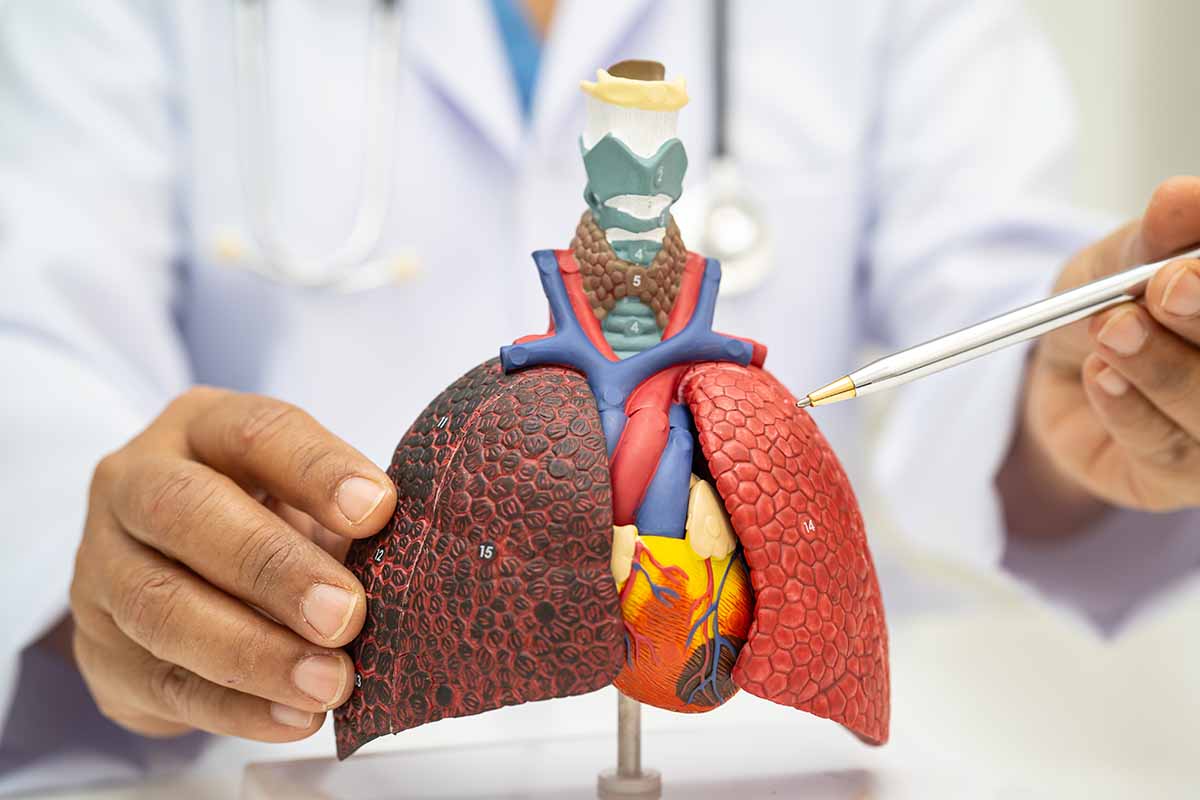Introduction to Obstructive vs Restrictive Lung Disease
Obstructive vs restrictive lung disease. Yet when illness strikes, this delicate balance is disrupted, leading to profound consequences. Among the most significant breathing disorders are those falling under two distinct categories– limiting and obstructive lung diseases.
In an Introduction to Restrictive vs Obstructive Lung Disease, one needs first to comprehend that both conditions impair breathing, but through fundamentally different systems. Obstructive lung disease is marked by airflow obstruction, often brought on by narrowing of the airways, swelling, or mucus build-up. This makes exhalation a laborious task, leaving stagnant air caught in the lungs.
This reduction in lung volume can originate from stiffened lung tissue, defects of the chest wall, or neuromuscular disabilities. The outcome is decreased air intake, and consequently, minimized oxygen supply to the body.
Recognizing the distinction between these two kinds is vital. The technique for lifestyle, prognosis, and treatment adjustment varies significantly depending on the medical diagnosis. Hence, an Introduction to Restrictive vs Obstructive Lung Disease functions as the foundation for both medical understanding and patient awareness.
Lung health is a cornerstone of vigor, yet it is frequently undervalued until troubles emerge. Among breathing ailments, restrictive and obstructive lung illness stand as two significant classifications, each impacting breathing in unique ways. Understanding their differences not only empowers patients but also sharpens the diagnostic focus for doctors.

Understanding the Respiratory System at a Glance
The respiratory system is a finely tuned network, designed to sustain life by making sure a continuous exchange of crucial gases. Air goes into the body through the nose or mouth, travels down the trachea, and branches into the bronchi, which further divide into smaller bronchioles. These cause the alveoli–microscopic sacs where oxygen slips into the bloodstream and CO2 is expelled.
In Understanding the Respiratory System at a Glance, it becomes clear that this process is more than basic inhalation and exhalation. The lungs work closely with the heart, blood vessels, and muscular structures to provide oxygen effectively to every cell. Each breath shows a precise orchestration of diaphragm contractions, airway patency, and vascular perfusion.
Disturbances anywhere along this path–whether from swelling, obstruction, or tissue stiffness–can impair gas exchange and stress the body’s systems. This is why even minor respiratory inadequacies can manifest as tiredness, breathlessness, or lightheadedness.
By delving into Understanding the Respiratory System at a Glance, one values not only the elegance of this physiological design but also its vulnerability. Safeguarding this system is paramount, for its health directly identifies the body’s vitality and resilience against disease.
The human respiratory system is a complex network of air passages, lungs, and blood vessels, working in concert to oxygenate the body. Air travels through the nose or mouth, down the trachea, into the bronchi, and finally into the fragile alveoli, where gas exchange happens. Even a slight interruption in this system can have a drastic impact on health.
Why Lung Disease Classification Matters for Diagnosis
Accuracy in medication starts with precise recognition. In respiratory health, Why Lung Disease Classification Matters for Diagnosis depends on its ability to differentiate between conditions that might provide comparable symptoms yet demand different treatments. Wheezing, shortness of breath, and persistent cough can come from several causes; however, without a correct diagnosis, therapy can be inefficient or even harmful.
Obstructive lung illness, such as asthma or chronic obstructive pulmonary disease, requires strategies to open narrowed airways and reduce inflammation. Restrictive lung illness, on the other hand, calls for interventions intended to enhance lung growth and resolve underlying tissue rigidity. Misinterpreting one for the other can postpone recovery and worsen prognosis.
By focusing on Why Lung Disease Classification Matters for Diagnosis, health care professionals can tailor diagnostic screening, such as spirometry or imaging, to verify the precise nature of the condition. This ensures that treatment strategies are not generic, but targeted, delivering optimum healing benefit with minimal risk.
Ultimately, understanding Why Lung Disease Classification Matters for Diagnosis is not just a clinical need; it is crucial for patient outcomes. The right classification results in timely intervention, enhanced care, and a greater opportunity of protecting long-term lung function.
Accurate classification enables targeted treatment. Without a clear identification of whether a condition is obstructive or limiting, therapy may be misdirected. This distinction guides not only medication choices but also long-lasting management techniques.

Specifying Obstructive Lung Disease in Simple Terms
Breathing needs to be simple and easy, yet in obstructive lung illness, each exhalation can feel like pushing air through a narrow straw. In Defining Obstructive Lung Disease in Simple Terms, it refers to a group of conditions where airflow is hindered, mainly during breathing out. The obstruction develops from inflammation, mucus accumulation, or structural changes that constrict the air passages.
This restriction traps stale air within the lungs, reducing the amount of fresh oxygen-rich air that can enter with the next breath. Common offenders include asthma, persistent bronchitis, and emphysema– each with its causes but sharing the same outcome: restricted airflow.
When Defining Obstructive Lung Disease in Simple Terms, it is crucial to understand that the lungs themselves may still expand generally. This ineffectiveness results in symptoms such as persistent coughing, wheezing, chest tightness, and shortness of breath, particularly during exertion.
Early recognition is essential, as targeted treatments–like bronchodilators, inhaled steroids, and lifestyle changes–can considerably improve breathing and slow disease progression. In essence, Defining Obstructive Lung Disease in Simple Terms indicates acknowledging it as a battle against narrowed air passages, where restoring air flow is essential to regain vitality. Obstructive lung illness is identified by narrowed or blocked respiratory tracts, making it challenging to breathe out completely. Air becomes caught, causing shortness of breath and reduced oxygen circulation. Typical examples consist of asthma, chronic bronchitis, and emphysema.
Specifying Restrictive Lung Disease in Simple Terms
In Defining Restrictive Lung Disease in Simple Terms, it describes a condition where the lungs cannot fully expand, restricting the amount of air they can hold. Unlike obstructive disorders, where airflow is hindered, limiting lung disease is defined by a reduction in lung volume. This restriction makes breathing feel shallow and less gratifying, even when no airway clog exists.
The cause frequently depends on stiffened lung tissue, damaged breathing muscles, or structural irregularities of the chest wall. Conditions such as lung fibrosis, scoliosis, and certain neuromuscular disorders are prevalent triggers. In time, this minimized versatility hinders the body’s ability to take in enough oxygen, causing tiredness, shortness of breath, and diminished endurance.
When Defining Restrictive Lung Disease in Simple Terms, it helps to think of attempting to pump up a balloon that is made from thick, stiff material. No matter how much effort is applied, the balloon can not extend to its full capacity.
Precise diagnosis is vital, as treatment concentrates on addressing the underlying cause, lowering inflammation, and enhancing breathing mechanics. Ultimately, Defining Restrictive Lung Disease in Simple Terms implies understanding it as a battle for expansion– where the difficulty lies not in moving air out, but in drawing adequate life-sustaining air in.
Restrictive lung disease restricts the lungs’ ability to expand fully. This decrease in capacity indicates less air is attracted with each breath, eventually reducing oxygen supply to the body. Conditions such as pulmonary fibrosis and sarcoidosis fall under this category.
How the Two Categories Differ in Lung Function
In How the Two Categories Differ in Lung Function, the contrast depends on the mechanics of breathing and the constraints each imposes. Obstructive lung diseases hinder the circulation of air, mainly during exhalation. Narrowed airways, extreme mucous, or structural modifications slow the release of air, trapping it within the lungs. This develops a sensation of incomplete breathing and requires the lungs to work more difficult to expel each breath.
The lung tissue might become stiff, the chest wall might lose movement, or the respiratory muscles may weaken. Here, the trouble is not in expelling air, but in drawing enough in to fill the lungs.
When examining how the Two Categories Differ in Lung Function, obstructive conditions present with a lowered airflow rate, while limiting conditions show a lessened lung capacity. Pulmonary function tests highlight this distinction, guiding treatment toward either airway dilation or growth assistance.
Eventually, How the Two Categories Differ in Lung Function refers to understanding that both obstructive and restrictive patterns hinder breathing, yet each needs a unique clinical technique to restore performance and maintain breathing health.
The hallmark of obstructive illness is impaired airflow throughout exhalation, while limiting disease centers on reduced lung volume. Both impair breathing, however, through completely different systems.
Typical Causes of Obstructive Lung Disease
In checking out the Common Causes Behind Obstructive Lung Disease, it becomes clear that a combination of environmental, lifestyle, and biological factors typically assemble to impair respiratory tract function. Chief amongst these is chronic tobacco smoking, which exposes the lungs to a barrage of damaging chemicals that irritate and narrow the bronchial passages. Over time, this persistent irritation can lead to permanent respiratory tract damage.
Long-lasting direct exposure to airborne contaminants, industrial fumes, or fine particle matter is another significant factor. Employees in building and construction, mining, or chemical markets deal with a greater danger due to constant inhalation of dangerous substances. Asthma, though in some cases activated by allergens, falls within this classification when relentless respiratory tract tightness leads to obstructive patterns. Additionally, particular hereditary predispositions, such as alpha-1 antitrypsin deficiency, can speed up the onset of emphysema, even in non-smokers.
Understanding the Common Causes Behind Obstructive Lung Disease highlights the significance of prevention– lessening direct exposure to irritants, quitting smoking cigarettes, and handling breathing infections promptly. By dealing with these origins, the danger of establishing persistent airway blockage can be substantially lowered, maintaining lung function and total vigor.
Persistent smoking, exposure to airborne toxins, and prolonged respiratory infections are regular perpetrators. Hereditary aspects, such as alpha-1 antitrypsin deficiency, might likewise predispose people.
Common Causes of Restrictive Lung Disease
Restrictive lung disease mainly stems from conditions that decrease lung compliance or limit the chest wall’s ability to expand.
Pulmonary fibrosis stands apart as a predominant cause– this disorder changes healthy lung tissue with dense, inflexible scar tissue, dramatically hindering the lungs’ flexibility. Prolonged direct exposure to breathed-in toxic substances, such as asbestos, silica, or certain chemical fumes, can initiate this fibrotic process.
Structural irregularities of the chest wall, consisting of extreme scoliosis or ankylosing spondylitis, limit the thoracic cavity’s movement, which in turn limits lung growth. Neuromuscular illness, such as amyotrophic lateral sclerosis or muscular dystrophy, compromises the muscles accountable for breathing, thus constraining lung capability.
Furthermore, obesity-related hypoventilation syndrome can contribute by exerting mechanical pressure on the lungs and diaphragm, further lowering lung volumes.
A detailed grasp of the Common Causes Behind Restrictive Lung Disease is necessary for early medical diagnosis and customized treatment, as resolving these root factors can prevent further progression and improve respiratory function.
This classification frequently comes from scarring of lung tissue, defects in the chest wall, or neuromuscular disorders that weaken breathing muscles. Long-term direct exposure to asbestos or silica dust can also contribute.

Key Risk Factors That Increase Vulnerability
Breathing health is affected by a myriad of variables, and recognizing the Key Risk Factors That Increase Vulnerability to lung disease is crucial for prevention and early intervention. Cigarette smoking remains the most significant contributor, causing hazardous damage that compromises airway integrity and lung tissue. Even previously owned smoke can cause dangerous results, making non-smokers susceptible.
Ecological exposures likewise play a crucial role. Extended contact with commercial contaminants, dust, chemical fumes, and airborne particulates increases the threat of both obstructive and limiting lung conditions. Age naturally increases vulnerability; the lungs’ elasticity decreases gradually, rendering older adults more prone to disease development. Genetic predispositions, such as acquired deficiencies or familial breathing conditions, further enhance danger.
Hidden medical conditions– consisting of autoimmune illness, persistent infections, and obesity– can compromise lung function and resilience. Occupational dangers, particularly in mining, construction, or manufacturing sectors, should not be ignored.
Comprehending these Key Risk Factors That Increase Vulnerability empowers clinicians and individuals alike to embrace protective measures, focus on screenings, and tailor lifestyle options. Through watchfulness and proactive management, the problem of lung disease can be alleviated before irreversible damage takes place.
Cigarette smoking, occupational hazards, poor air quality, and a household history of lung disease all increase susceptibility. Age and underlying health conditions further elevate the threat.
Illness Commonly Classified as Obstructive
Within the realm of breathing conditions, a distinct group of disorders falls under the umbrella of Diseases Commonly Classified as Obstructive. These conditions share a hallmark function: obstruction of air flow, particularly during exhalation, causing shortness of breath and impaired gas exchange.
Persistent obstructive lung disease (COPD) stands at the forefront, incorporating emphysema and chronic bronchitis. Emphysema involves damage to alveolar walls, diminishing the lungs’ area for oxygen absorption. Persistent bronchitis, meanwhile, is identified by consistent inflammation and mucus hypersecretion that narrows the airways.
Asthma likewise belongs to this classification, marked by reversible airway constraint activated by irritants, exercise, or irritants. Though typically episodic, asthma can substantially limit air flow during attacks.
Bronchiectasis, a less common but extreme obstructive disease, involves irreversible dilation of the bronchi, typically due to repeated infections, causing persistent cough and sputum production.
Acknowledging these Diseases Commonly Classified as Obstructive is essential for targeted intervention. Treatments intend to alleviate respiratory tract blockage, reduce inflammation, and prevent exacerbations, ultimately protecting lung function and improving quality of life for those afflicted.
Illness Commonly Classified as Restrictive
A spectrum of conditions is incorporated by the term Diseases Commonly Classified as Restrictive, all merged by a shared trademark: diminished lung capability due to impaired growth. Unlike obstructive diseases that obstruct airflow, restrictive conditions stiffen lung tissue or jeopardize the chest wall, limiting the volume of air the lungs can hold.
Pulmonary fibrosis is among the most prevalent in this category, characterized by progressive scarring that renders lung tissue rigid and unyielding. This fibrosis interrupts the fragile alveolar architecture, considerably minimizing oxygen transfer. Interstitial lung diseases, a varied group typically including swelling and scarring of the lung interstitium, also fall under this umbrella.
Particular systemic conditions, such as sarcoidosis, provoke granulomatous swelling, which stiffens the lung parenchyma and limits expansion. Neuromuscular illness, consisting of amyotrophic lateral sclerosis and muscular dystrophy, compromises the muscles essential for reliable respiration, resulting in reduced lung volumes.
Skeletal defects like serious scoliosis or ankylosing spondylitis can mechanically restrict chest wall motion, intensifying respiratory constraints.
Appreciating Diseases Commonly Classified as Restrictive is crucial, as their management typically revolves around addressing underlying causes, mitigating fibrosis, and supporting respiratory function through customized therapies. Early acknowledgment remains crucial to preserving lung capacity and quality of life
Lung fibrosis, interstitial lung disease, sarcoidosis, and scoliosis-related breathing restrictions are case in points.
Conclusion and Key Takeaways on Lung Disease
Understanding the differences between obstructive and restrictive lung disease is essential for reliable treatment and avoidance. Awareness, prompt medical diagnosis, and lifestyle alertness remain the strongest defenses against respiratory decline.
Limiting lung illness, conversely, restricts the lungs’ ability to expand completely. Limiting lung illness, on the other hand, calls for interventions intended to enhance lung growth and deal with underlying tissue rigidity. When Defining Obstructive Lung Disease in Simple Terms, it is important to comprehend that the lungs themselves might still expand generally. Unlike obstructive disorders, where air flow is hindered, limiting lung disease is defined by a reduction in lung volume. Interstitial lung diseases, a diverse group typically involving swelling and scarring of the lung interstitium, also fall under this umbrella.
